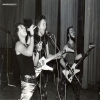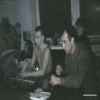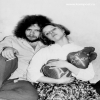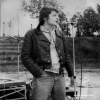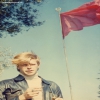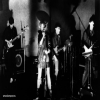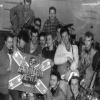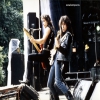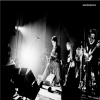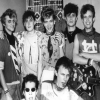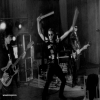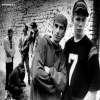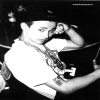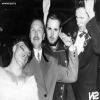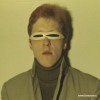

Music
|
Musical activity of the 80’s was an equally complex event, involving not only jazz, rock and new wave, but also some desperate experiments in sound-making and downwright simulative groups like Mukhomory (Fly agarics), DK, Trud (Labour), Srenderusskaya Vozvyshennost (Midrussian Heights), Vakhtang Kikabidze’s Waterfall – some of them had very few live gigs, others none at all. But it doesn’t make their contribution into the common bank of underground of the 80’s any less. Besides the conditions in the beginning of the 80’s were not inviting for many groups to play concerts, but with the outspread of information about rock and audiotapes they made their statements and their depiction of reality through musical pieces. In times of the traditional concerts in peoples flats and the beginning of rock persecution, musicians who didn’t tend to concert playing even took advantage of this situation. The forbiddenness attracted new flock and shaped the mythology. One should say, that in much more free Leningrad the situation was more liable to the uprise of rock-movement, what actually happened in the end of the 70’s, but the paradigm change, so to say, took place not only in capitals but also in other cities of the USSR. The new array of groups appeared, some of them inclined to musical experiments, others – to heavier rock styles. And if the first ones won recognition from the student public, the second ones precipitated themselves into organizing underground concerts, wherewith just aggravated the fobiddenness and provoked the opening of rock-clubs under the Komsomol aegis. It is worth mentioning that the legalization of rock started already in mid 80’s, the groups playing soviet rockabilly and proletarian jazz with censored texts were allowed to get onto the semi-official and official scenes under the organizations’ control. Radical and wild-growing groups were granted this only by the end of the 80’s, when rock was integrated into the soviet pop canvas, some compositions appeared on television and in movies, and the groups started touring not only inside the country, but abroad as well. A new wave of music groups, formed during this period - original enough despite many foreign style borrowings - in the second half of the 80’s was called the Red wave following Joanne Stingray’s example, though very few groups have got into the album with the same title and many groups never associated themselves with this wave. Music activity was like a chemical reaction on the situation in the country. Some were temporizing with social issues, others contrived to turn it into the musical surrealistic folk, some seriously tried to play on the international level, for some (like many punks) it was just a way to have fun and make things lively for everybody. To sum up it may be said that the movement, formed upon love to rock-music, generally overlooked the technical deficiency and ignorance of its idols and colleagues – for many rock was more than just music. It was a way of life and a communication with many names, that are now forgotten. On the verge of the 90’s another change of generations took place and a new cast of music makers appeared, who experimented with hip-hop, psychobilly, reggae and indie. They existed independently, as far as situation allowed, until rave came to country and the most part of broadcasting, aside from pop and electronic music, was swept with a new format, the so called Russian rock of the 90’s, implanted by radio and TV.  go back to "Art& Music" go back to "Art& Music" |

